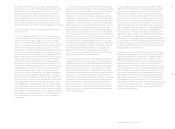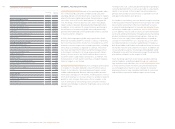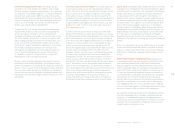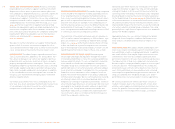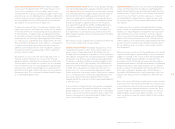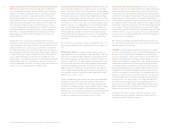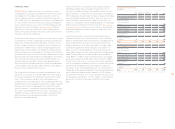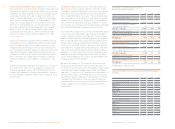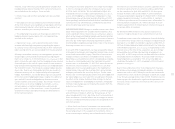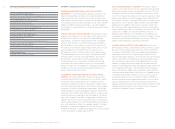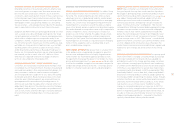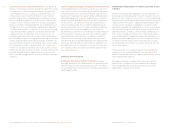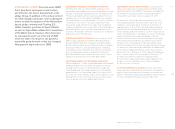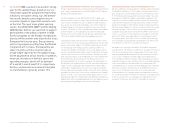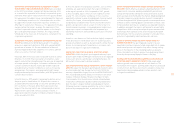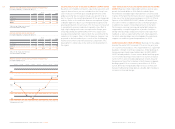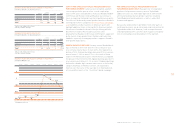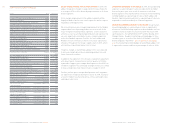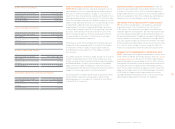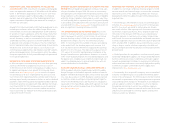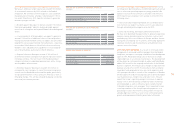Reebok 2007 Annual Report Download - page 119
Download and view the complete annual report
Please find page 119 of the 2007 Reebok annual report below. You can navigate through the pages in the report by either clicking on the pages listed below, or by using the keyword search tool below to find specific information within the annual report.115
ANNUAL REPORT 2007 --- adidas Group
03
EMERGING MARKETS AS LONG-TERM GROWTH DRIVERS
Emerging economies in Asia, Europe and Latin America have
consistently grown at stronger rates than more mature mar-
kets over the last several years. However, due to economic
constraints, sports participation in most of these countries has
historically been lower than in industrialized countries. Now,
rising real incomes and employment rates as well as positive
demographic trends and a growing middle class are fueling
these economies – and subsequently our industry. This develop-
ment is expected to continue for at least three to fi ve years.
European and North American sporting goods brands are often
seen as easily accessible, affordable luxury goods. Our Group
currently generates around 25 % of sales in emerging markets,
which refl ects a higher exposure compared to many of our
competitors. Further, we believe we have excellent opportuni-
ties for further growth, in particular in China and Russia. Sup-
ported by our strong portfolio of partnerships, e. g. the NBA,
Yao Ming and the China Golf Association in China as well as
Andrij Shevchenko and the Russian Basketball Federation in
Russia, our strong market positions and our extensive distribu-
tion network, we aim to reach sales of € 1 billion in China,
while Russia is expected to become our biggest market in
terms of sales and profi ts in Europe by 2010.
GROWING POPULARITY OF “GREEN” PRODUCTS Today’s
consumers are increasingly concerned about the impact their
consumption has on the environment. Therefore, they demand
more and more products that are environmentally benign. For
many consumers, materials used in footwear and apparel
are now expected to be suitable for re-use, while still looking
fashionable and stylish. By positioning ourselves in this fi eld
within the sports lifestyle segment, we can benefi t from the
growing demand for environmentally friendly products. In
2008, we are launching the adidas Grün collection within our
adidas Sport Style division. The collection consists of footwear
and apparel made of organic, untreated or recycled materials
such as cork, manila and linen. We expect consumer demand
for environmentally friendly products to increase going for-
ward.
STRATEGIC AND OPERATIONAL OPPORTUNITIE
S
STRONG MARKET POSITIONS WORLDWIDE The adidas Group
has the highest market share in numerous countries around
the world. This strong competitive position offers us many
advantages in terms of global brand visibility, market power
and the ability to effectively expand our position in emerging
markets. As a result of our strong partnership portfolio and
marketing efforts, consumers around the globe are highly
aware of our brands and are receptive to our brand messaging.
This makes demand for our products more stable compared to
smaller competitors. Hence, many retailers consider our
products as core to their offering. The adidas Group is there-
fore in a strong bargaining position and can compete more
effectively for shelf space. Our local market knowledge and
marketing power also enable us to quickly react to emerging
trends in niche categories such as skateboarding or even
enter completely new categories.
MULTI-BRAND APPROACH We believe there is a natural limit
to the audience size a single brand can appeal to, given the
diverse tastes and expectations of a highly-fragmented con-
sumer market. Our multi-brand approach provides us with
the opportunity to leverage the power of our brands in a more
precise and meaningful way. see Group Strategy, p. 044 We are able
to utilize the combined strengths of each brand to compete for
a higher percentage of the total market – covering a greater
number of consumer needs, price points and demographics.
PERSONALIZATION AND CUSTOMIZATION REPLACING MASS
WEAR Today’s consumers are looking for choice and variety
that goes beyond choosing from a wide selection of products.
We engage in developing unique and relevant products that fi t
specifi c functional and aesthetic requirements. see Group Strategy,
p. 044 adidas, Reebok and TaylorMade-adidas Golf all offer
different personalization and customization platforms
refl ecting each brand’s strategy. Key concepts include the
adidas “mi Innovation Center” and Reebok’s “Rbk Custom”
online platform. Utilizing the newest body mapping technology,
consumers can personalize our most innovative and popular
footwear styles to their own fi t and performance needs. We
believe this technology leads the way in sporting goods retail
and have started to roll out “mi Innovation Centers” through-
out our concept stores in 2007. “Rbk Custom” is a web-based
platform over which consumers can customize footwear. Shoes
are then shipped within ten business days. We expect the
market for personalized and customized footwear, apparel and
hardware to grow strongly and evolve further in the coming
years.
BREAKING NEW GROUND IN DISTRIBUTION The sporting goods
retail environment is changing constantly. People increasingly
want to get involved with our brands. We have adapted our
distribution to cater to this change and have made controlled
space initiatives a strategic priority. We will start introducing
e-commerce in the Netherlands as a test market for Europe in
2008. We also see opportunities to operate new shop formats
in cooperation with other brands. In 2007, we opened the “NHL
Powered by Reebok” store in New York, showcasing Reebok’s
broad choice of hockey products. Similarly, adidas opened the
fi rst European NBA Concept Shop in Istanbul, Turkey. Through
initiatives like these, we can more effectively target consumers
and involve them emotionally with our products. In our whole-
sale business, we are increasing our fl exibi lity to utilize
changes in consumption behavior as they arise. In 2007, for
example, we actively strengthened our North American distri-
bution in the growing sporting goods retail channel. Here, we
are able to showcase a much broader choice of our footwear –
and particularly apparel products – compared to the athletic
specialty channel where industry sales decreased.


